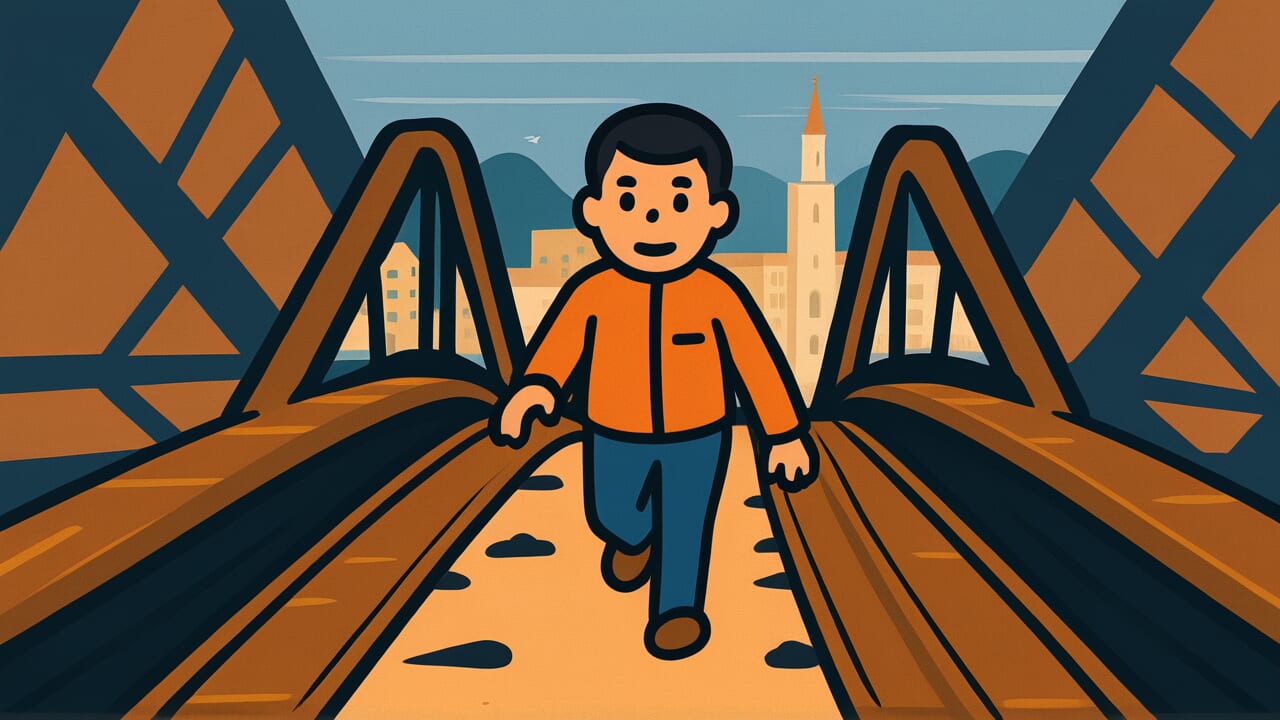How to Read “Cross a dangerous bridge at least once”
Abunai hashi mo ichido wa watare
Meaning of “Cross a dangerous bridge at least once”
This proverb teaches that you can’t achieve great success by always choosing safe and steady paths. Sometimes you need to take on challenges even when you know they’re risky.
In life, avoiding all risks is certainly safe. But it also means you’ll never open up new possibilities.
To achieve great results, you need the courage to take some risks. This proverb expresses the importance of such challenges through the concrete image of a “dangerous bridge.”
People use this saying to encourage someone who’s hesitating about a risky decision. This might be starting a new business, changing careers, or studying abroad.
It’s also used to urge young people to have the courage to try things without fearing failure.
Today, as people increasingly seek stability, this proverb reminds us to recognize the value of taking on challenges.
Origin and Etymology
No clear written records explain the origin of this proverb. However, we can make interesting observations from how the phrase is constructed.
The expression “dangerous bridge” is deeply connected to Japan’s geographical features. Japan has mountainous terrain with many valleys and rivers.
Bridges have been important transportation routes since ancient times. In mountain areas especially, many bridges were simple structures made of logs or unstable suspension bridges. Crossing them required considerable courage.
The act of “crossing a bridge” symbolized more than just movement. It represented a challenge to reach a new world on the other side.
If you avoid a dangerous bridge and turn back, you stay safe. But you never reach your destination. If you gather your courage and cross, new lands and new opportunities await you.
The phrase “at least once” contains the wisdom of our ancestors about the necessity of taking risks in life.
Always choosing safe paths won’t expand your life’s possibilities. The teaching is that challenging experiences, taken knowingly despite danger, help people grow.
Some say this was used in the world of Edo period merchants and craftsmen. It encouraged people to take on the challenge of independence or starting new businesses.
Usage Examples
- They say cross a dangerous bridge at least once, so I think I’ll try starting my business now while I can
- I’m anxious about leaving my stable company, but I’ve decided to trust the words “cross a dangerous bridge at least once” and take a new path
Universal Wisdom
This proverb has been passed down for so long because it brilliantly captures a fundamental duality in human nature. Everyone has conflicting feelings: the desire for safety and the longing for the unknown.
As living creatures, we evolved to avoid danger. Staying in safe places is a basic survival strategy.
But at the same time, humans have curiosity. We also have the desire to explore new worlds. We constantly waver between these two contradictory impulses.
What’s interesting is that this proverb doesn’t say “always cross dangerous bridges.” The word “at least once” contains deep wisdom.
It doesn’t tell you to bet your entire life. But it reflects our ancestors’ insight that a life without any challenges will leave you with regrets.
When people stay in their comfort zone too long, they eventually think “if only I had tried back then.” The older you get, the bigger the regret about not taking chances becomes.
Our ancestors deeply understood this human psychology. That’s why they left this teaching: try taking a risk at least once while you’re young, while you still have physical and mental energy.
This proverb is a timeless prescription for living without regrets.
When AI Hears This
Before crossing a dangerous bridge, we judge “this is dangerous” based only on imagination. This is what Bayesian statistics calls prior probability—prediction before experience.
But once you cross it, you learn the actual level of danger. How much the bridge sways, the strength of the planks, whether you’ll really fall. Updating your prediction with this raw data gives you posterior probability.
What’s interesting is the limitation of “at least once.” In information theory, repeating the same action yields rapidly diminishing new information.
The first crossing reveals the bridge’s structure. The second time gives you almost the same information. In other words, the marginal utility of information decreases.
Meanwhile, the risk exists equally every time. If a bridge has 30 percent danger, you face a 30 percent accident probability each crossing.
Even more important is the trap of survivorship bias. Only people who crossed safely can say “you can cross dangerous bridges.” Those who fell can’t give advice.
So the expression “cross at least once” hides the statistically invisible failed people. This proverb recommends only the first crossing, where information value exceeds risk.
It implicitly warns against irrational second and subsequent challenges. It’s an extremely sophisticated life strategy from a probability perspective.
Lessons for Today
Modern society provides us with an unprecedentedly safe and predictable environment. But at the same time, we may be losing opportunities to take on challenges.
What this proverb teaches is the importance of having courage to test your potential at least once in your life.
It doesn’t have to be a huge gamble. Learning a new skill, switching to an unfamiliar field, or realizing an idea you’ve nurtured for years—your “dangerous bridge” exists in various forms.
What matters is not fearing failure too much. Even if you try and fail, that experience helps you grow.
In fact, regret about not trying often weighs more heavily on your life.
If you see a “dangerous bridge” before you now, it might be a chance life has given you.
Don’t wait for perfect preparation. Take one step forward with what you can do now. That courage might become the turning point that greatly changes your life.



Comments